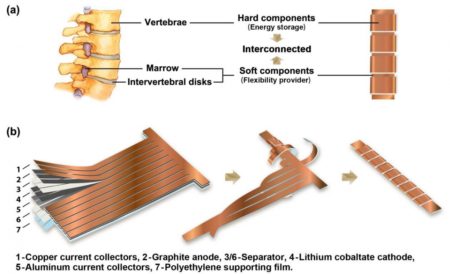Feb
8
Flexible Lithium Battery Design For Wearable Electronics
February 8, 2018 | 1 Comment
Columbia University School of Engineering and Applied Science engineering researchers have developed a prototype of a high-performance flexible lithium-ion battery. The battery design demonstrates both good flexibility and high energy density at the same time.
The very cleverly designed battery is shaped like the human spine and allows remarkable flexibility, high energy density, and stable voltage no matter how it is flexed or twisted. The device could help advance applications for wearable electronics.

Schematic of the structure and the fabrication process of Yang’s spine-like battery. (a) Schematic illustration of bio-inspired design, the vertebrae correspond to thick stacks of electrodes and soft marrow corresponds to unwound part that interconnects all the stacks. (b) The process to fabricate the spine-like battery, multilayers of electrodes were first cut into designed shape, then strips extending out were wound around the backbone to form spine-like structure. Image Credit: Yuan Yang/Columbia Engineering. Click image for the largest view.
The rapid development of flexible and wearable electronics is giving rise to an exciting range of applications, from smart watches and flexible displays – such as smart phones, tablets, and TV – to smart fabrics, smart glass, transdermal patches, sensors, and more.
With this increase in product range, demand has increased for high-performance flexible batteries. But up to now researchers have had difficulty obtaining both good flexibility and high energy density concurrently in lithium-ion batteries.
A team led by Yuan Yang, assistant professor of materials science and engineering in the department of applied physics and mathematics at Columbia Engineering, has developed a prototype that addresses this challenge: a lithium ion battery shaped like the human spine that allows remarkable flexibility, high energy density, and stable voltage no matter how it is flexed or twisted.
The study paper has been published in Advanced Materials.
Yang said, “The energy density of our prototype is one of the highest reported so far. We’ve developed a simple and scalable approach to fabricate a flexible spine-like lithium ion battery that has excellent electrochemical and mechanical properties. Our design is a very promising candidate as the first-generation, flexible, commercial lithium-ion battery. We are now optimizing the design and improving its performance.”
Yang, whose group explores the composition and structure of battery materials to realize high performance, was inspired by the suppleness of the spine while doing sit-ups in the gym. The human spine is highly flexible and distortable as well as mechanically robust, as it contains soft marrow components that interconnect hard vertebra parts. Yang used the spine model to design a battery with a similar structure. His prototype has a thick, rigid segment that stores energy by winding the electrodes (“vertebrae”) around a thin, flexible part (“marrow”) that connects the vertebra-like stacks of electrodes together. His design provides excellent flexibility for the whole battery.
Yang explained, “As the volume of the rigid electrode part is significantly larger than the flexible interconnection, the energy density of such a flexible battery can be greater than 85 percent of a battery in standard commercial packaging. Because of the high proportion of the active materials in the whole structure, our spine-like battery shows very high energy density – higher than any other reports we are aware of. The battery also successfully survived a harsh dynamic mechanical load test because of our rational bio-inspired design.”
Yang’s team cut the conventional anode/separator/cathode /separator stacks into long strips with multiple “branches” extending out 90 degrees from the “backbone.” Then they wrapped each branch around the backbone to form thick stacks for storing energy, like vertebrae in a spine. With this integrated design, the battery’s energy density is limited only by the longitudinal percentage of vertebra-like stacks compared to the whole length of the device, which can easily reach over 90 percent.
The battery shows stable capacity upon cycling, as well as a stable voltage profile no matter how it is flexed or twisted. After cycling, the team disassembled the battery to examine the morphology change of electrode materials. They found that the positive electrode was intact with no obvious cracking or peeling from the aluminum foil, confirming the mechanical stability of their design.
To further illustrate the flexibility of their design, the researchers continuously flexed or twisted the battery during discharge, finding that neither bending nor twisting interrupted the voltage curve. Even when the cell was continuously flexed and twisted during the whole discharge, the voltage profile remained. The battery in the flexed state was also cycled at higher current densities, and the capacity retention was quite high (84% at 3C, the charge in 1/3 of an hour). The battery also survived a continuous dynamic mechanical load test, something rarely reported in earlier studies.
Yang said, “Our spine-like design is much more mechanically robust than are conventional designs We anticipate that our bio-inspired, scalable method to fabricate flexible Li-ion batteries could greatly advance the commercialization of flexible devices.”
It is a brilliantly clever design. One just hopes that the battery construction process isn’t expensive, because that comparison is the make or break point on what designs get to commercial scale. It looks low cost, maybe even CNC level or better, a process engineer will find this entrancing.
Comments
1 Comment so far


As the volume of the rigid electrode part is significantly larger than the flexible interconnection, the energy density of such a flexible battery can be greater than 85 percent of a battery in standard commercial packaging.